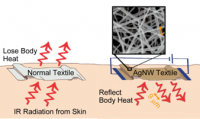Photonic Structure Textiles

Technology Description:
Stanford University will develop transformative methods for integrating photonic, or radiant energy structures into textiles. Controlling the thermal photonic properties of textiles can significantly influence the heat dissipation rate of the human body, which loses a significant amount of heat through thermal radiation. To achieve heating, the team utilizes metallic nanowire embedded in textiles to enhance reflection of body heat. To achieve cooling, the team utilizes visibly opaque yet infrared transmissivity (IR) transparent textile. These techniques for heating and cooling have not yet been achieved to date. The team will leverage advances in photonic structures to build textiles with varying amounts of infrared transparency and reflectivity to enable a wearer to achieve comfort in a wider temperature range, and therefore generate a substantial reduction of energy consumption for both heating and cooling.
Potential Impact:
If successful, DELTA technology could increase energy efficiency, reduce emissions produced by powering traditional HVAC systems, and enable more sustainable heating and cooling architectures for energy-efficient building design.
Security:
The innovations developed under the DELTA program have the potential to increase energy efficiency, improve overall building performance, and reduce HVAC energy consumption by at least 15%.
Environment:
The heating and cooling of buildings generates about 13% of the U.S. domestic greenhouse gas emissions. Through improved utilization of energy produced by fossil fuels with full adoption DELTA can reduce these emission by 2%.
Economy:
DELTA program innovations can help U.S. businesses eventually reduce reliance on tightly controlled building environments, thus enabling radical and sustainable architecture in next generation energy efficient building designs.
Contact
ARPA-E Program Director:
Dr. Jennifer Gerbi
Project Contact:
Prof. Shanhui Fan
Press and General Inquiries Email:
ARPA-E-Comms@hq.doe.gov
Project Contact Email:
shanhui@stanford.edu
Related Projects
Release Date:
04/29/2014
